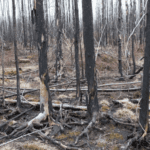Canadian Britt Wray is based at the University of Copenhagen’s Center for Synthetic Biology, doing a PhD in a field you’ve probably never heard of. Financially supported by the University of Copenhagen’s Excellence Programme and Canada’s Social Sciences and Humanities Research Council (SSHRC), she’s developing new methods for science communication in synthetic biology using her art and radio experience.
The Synthetic Biology Project describes synthetic biology as “an emerging area of research that can broadly be described as the design and construction of novel artificial biological pathways, organisms or devices, or the redesign of existing natural biological systems.”
Wray’s thesis requires that she study and understand not only the details of synthetic biology, but also science communication. It’s an interdisciplinary project that seems specifically designed for her.

Credit: Arden Wray
“I was on Twitter one day and noticed that people were tweeting about an open PhD position at the University of Copenhagen. I couldn’t believe how well this esoteric PhD fit the description of my life and research activities, as I’d moved from studying biology to making art about synthetic biology and then becoming a science communication broadcaster. The ad fit my profile eerily well.”
She maintains that, had she not checked Twitter at that exact moment, she would never have learned about the position. “I never saw the PhD position advertised anywhere before or after that one small window of time when I checked Twitter,” she says.
But how did she get to this point?
“In high school I had this romantic ideal of being a female scientist because they seemed to be rare in my world at the time, which made them interesting to my 17-year-old self. I was also inspired by David Attenborough and his life long career broadcasting the natural world with the BBC. This gave me the confidence to pursue science, even though I felt I might be a better writer than researcher.”
Wray graduated from Queen’s University in 2008 with a BSc in biology. While at Queen’s, she also started a science radio show on the local campus-community radio station, and fell in love with making science come to life through conversation and montage.




